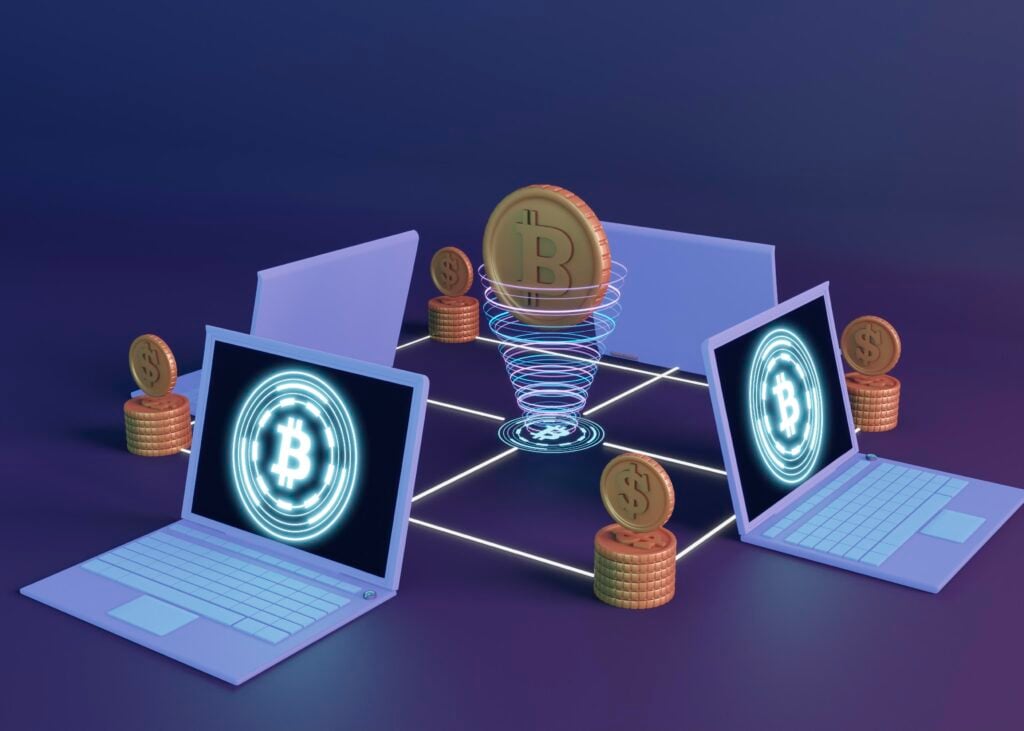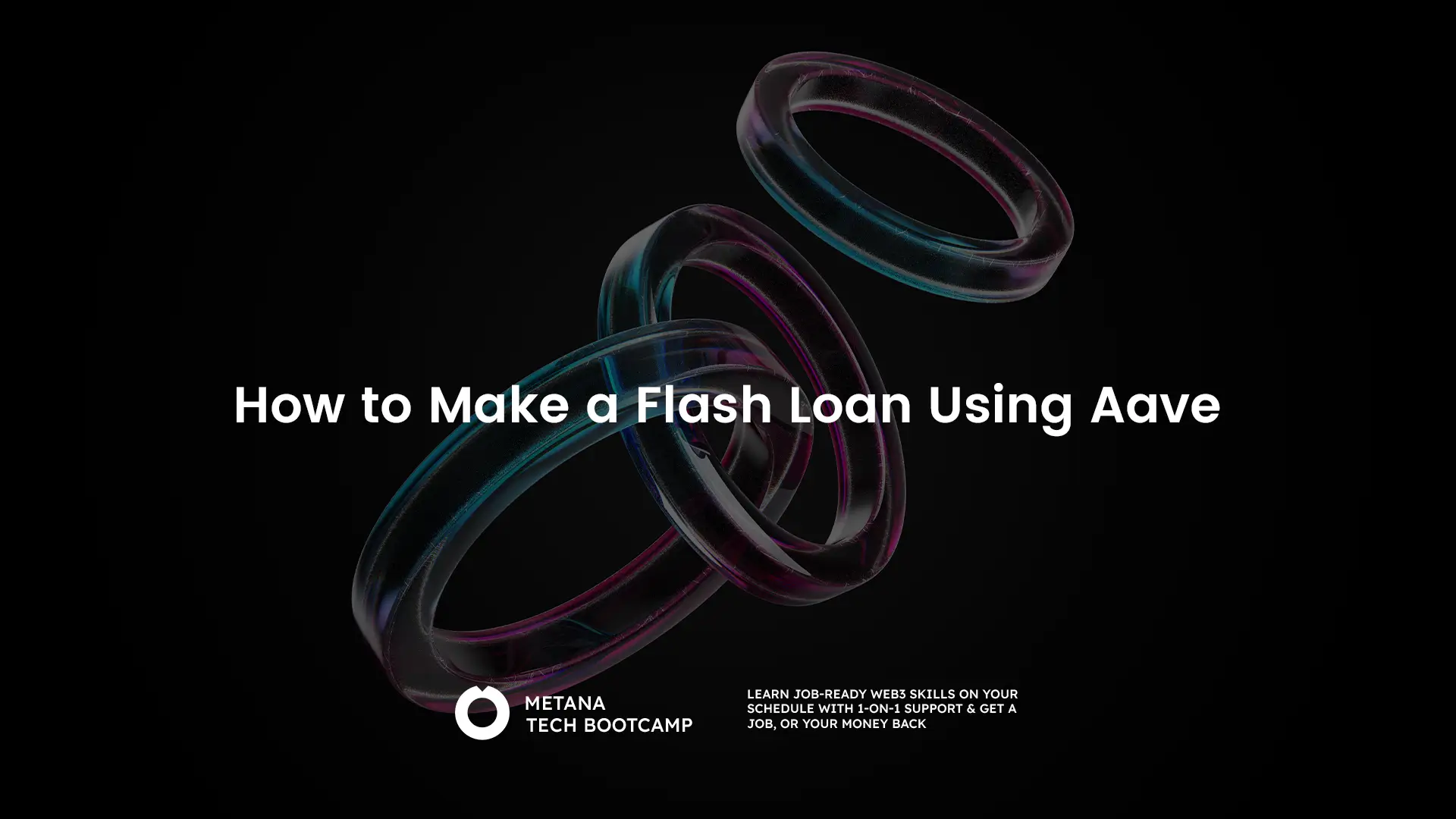TL;DR:
- Flash loans are uncollateralized loans that must be borrowed and repaid within a single transaction block, primarily used for arbitrage opportunities.
- Aave is a decentralized finance (DeFi) protocol on the Ethereum blockchain that offers flash loan services.
- To execute a flash loan on Aave, users can access the platform through a web interface or by interacting with the protocol directly through smart contracts.
- Benefits of flash loans include capital efficiency and liquidity provision, while risks involve planning and execution challenges, as well as price volatility.
- Understanding the mechanics and risks of flash loans is crucial for effectively leveraging them within the DeFi ecosystem.
Flash loans are a super cool new idea in the world of decentralized finance (DeFi). They let users borrow as much money as they want without needing to put up anything as collateral. The only catch is that the loan has to be paid back in the same transaction block. Aave is a platform you might know that lets you do this. In this article, we’re going to show you how to set up a flash loan using Aave. This could be really important for doing well in the DeFi world.
What is a Flash Loan?
Flash loans are loans that you don’t need to put anything up for. They are taken out and paid back in one single transaction. This means you can borrow lots of money without having to use your own stuff as a guarantee.
One of the best things about flash loans is how fast they are. Because everything happens in one transaction, you can get the money almost right away. This lets you use the money quickly and could let you make a lot of money.
Flash loans are mostly used for something called arbitrage. This is when traders use flash loans to take advantage of different prices on different exchanges. By borrowing money, making trades, and paying back the loan all in one transaction, traders could make money from these price differences.
What is Aave?
Aave is a way to lend and borrow different kinds of cryptocurrencies. It’s built on the Ethereum blockchain and even offers things like flash loans.
You can use Aave on the web or by using smart contracts. Aave works with different kinds of assets, so you can choose what you want to borrow or lend. You can even earn interest on the assets you deposit.
Aave has its own token called AAVE. If you have AAVE, you can help make decisions about how Aave works and vote on changes to the platform. Plus, if you have AAVE, you can get discounts on fees.
How do Flash Loans Work on Aave?
To execute a flash loan on Aave, users can follow these steps:
- Access Aave: Users can access the Aave platform through a web interface or by interacting with the protocol directly through smart contracts.
- Borrowing process: Users can select the desired asset they want to borrow and specify the loan amount. Flash loans on Aave allow users to borrow up to the total liquidity available on the platform for that specific asset.
- Utilizing the funds: Once the flash loan is obtained, users can utilize the borrowed funds within the same transaction. This can include executing trades, arbitrage opportunities, or other DeFi strategies.
- Repayment: It is crucial to repay the flash loan within the same transaction to avoid the loan being reversed. If the loan is not repaid in full, the entire transaction will be reverted, and the borrowed funds will be returned to the lender.
Benefits and Risks of Using Flash Loans
| Benefits | Risks |
|---|---|
| Capital efficiency: Flash loans allow users to access a large amount of capital without having to provide collateral, enabling them to execute various strategies and take advantage of opportunities. | Planning and execution risks: Flash loans require careful planning and execution. Users need to thoroughly research and understand the strategies they want to implement to ensure successful repayment. |
| Liquidity provision: Flash loans provide liquidity to the DeFi ecosystem, allowing users to quickly access funds for different purposes. | Price volatility: The volatile nature of cryptocurrency markets can pose risks when using flash loans. Sudden price movements can impact the profitability of strategies and the ability to repay the loan. |
| Potential for high-profit opportunities: Flash loans enable users to execute complex trading strategies, arbitrage opportunities, and other DeFi activities that can potentially generate significant profits. | Transaction failures: If the flash loan is not repaid in full within the same transaction, the entire transaction will be reverted. This can result in the loss of borrowed funds and potential fees. |
To manage risks when using flash loans, it is important to conduct thorough research, plan strategies carefully, and consider diversification of strategies to mitigate potential losses.
Steps to Make a Flash Loan Using Aave
Doing a flash loan is a bit of a process, and here’s how you can roll with it:
1. Set Up the Development Environment:
You can create a flash loan through Solidity smart contracts in supported development environments. Two widely used environments are Truffle and Remix. In this guide, we’ll use Remix. Navigate to the Remix Online IDE website and accept the terms and conditions.
2. Setting Up A Compatible Wallet:
Begin by setting up a wallet compatible with Aave. MetaMask is a widely used option for this. Install the MetaMask extension on your browser and set up the wallet with its seed phrase.
3. Connecting Wallet to Aave:
Once your wallet is set up, visit the Aave platform and connect your wallet by selecting the connect wallet option. Choose MetaMask and follow the prompts to connect your wallet.
4. Writing the Smart Contract:
The next step involves writing a smart contract that includes functions to request the flash loan and utilize it for intended operations. This contract is written in Solidity, the programming language for Ethereum blockchain. Determine your logic to capitalize on market opportunities and code it within this contract.
5. Deploying the Smart Contract:
Deploy your smart contract on the Ethereum blockchain using a deployment platform. Truffle Suite is an example of a popular deployment platform. You need to pay gas fees in ETH for deploying the contract, so ensure you have sufficient ETH in your wallet.
6. Fund the Flash Loan:
Although flash loans don’t require collateral, they do need funds to be successful. Navigate to the Aave lending pool and connect your MetaMask wallet. Confirm the MetaMask permission request and click “Connect”. Supply some ETH from your MetaMask wallet by choosing ETH under the “Assets to Supply” column. You can supply as little as 0.01 ETH
7. Executing the Flash Loan:
With your contract deployed, you can now execute the flash loan. This involves calling the smart contract function that requests the flash loan, which in turn triggers the operations defined within the contract.
8. Repaying the Loan:
As per the definition of a flash loan, you must ensure that the loan is repaid within the same transaction. This includes the amount borrowed plus fees. If the loan isn’t repaid or the transaction fails due to some reason, the entire transaction gets reverted, and it’s as though it never happened.
It’s important to remember that flash loans require an advanced understanding of smart contracts and the Ethereum platform. Also, one must keep in mind the associated risks and implications of flash loans.
pragma solidity 0.8.10;
import "aave-v3-core/flashloan/base/FlashLoanSimpleReceiverBase.sol";
contract SimpleFlashLoan is FlashLoanSimpleReceiverBase {
constructor(address _addressProvider) FlashLoanSimpleReceiverBase(IPoolAddressesProvider(_addressProvider)) {}
function flashLoan(address _token, uint256 _amount) public {
address receiverAddress = address(this);
address asset = _token;
uint256 amount = _amount;
bytes memory params = "";
uint16 referralCode = 0;
POOL.flashLoanSimple(receiverAddress, asset, amount, params, referralCode);
}
function executeOperation(address asset, uint256 amount, uint256 premium, address initiator, bytes calldata params) external override returns (bool) {
uint256 totalAmount = amount + premium;
IERC20(asset).approve(address(POOL), totalAmount);
return true;
}
}The smart contract above requests a flash loan, then approves repaying the loan plus interest in the executeOperation() function.
Example Flash Loan Use Cases
Arbitrage
Arbitrage is the process of taking advantage of price discrepancies between different markets. For example, if a cryptocurrency is trading at $10 on one exchange and $10.10 on another exchange, an arbitrageur could borrow $10 from Aave, buy the cryptocurrency on the first exchange, and sell it on the second exchange for a profit of $0.10. The arbitrageur would then repay the flash loan, plus interest and fees, on the same transaction.
Collateral swapping
Collateral swapping is the process of exchanging one asset for another as collateral for a loan. For example, if a user has borrowed ETH against their BTC collateral and the price of BTC falls, the user may be at risk of liquidation. The user could use a flash loan to borrow ETH, repay their ETH loan, and swap their BTC collateral for ETH. This would allow the user to reduce their risk of liquidation without having to sell their BTC.
Liquidations
Liquidations occur when a borrower’s collateral falls below a certain value, known as the liquidation threshold. If this happens, the borrower’s collateral is sold to repay the loan. Liquidators can use flash loans to automate the liquidation process and profit from the price difference between the liquidation price and the market price.
Repaying loans with lower interest rates
Flash loans can also be used to repay loans with lower interest rates. For example, if a user has borrowed ETH at a high interest rate, they could use a flash loan to borrow ETH at a lower interest rate and repay their original loan. This would allow the user to save money on interest payments.
These are just a few examples of how flash loans can be used. Flash loans can be used to execute a wide variety of financial transactions, and new use cases are being discovered all the time.
It is important to note that flash loans are a complex financial instrument and should only be used by experienced users.

Conclusion
Flash loans have revolutionized the DeFi sector by providing a novel mechanism for users to borrow large amounts of capital without collateral on platforms like Aave. This practice involves a series of steps beginning with understanding how flash loans work, writing and deploying a smart contract, initiating the flash loan, utilizing borrowed assets for profitable purposes, and the crucial last step of repaying the loan within the same transaction block.
Aave’s flash loans essentially provide a risk-free strategy for lenders and expand the opportunities for developers and traders to access large pools of capital that can be repurposed for various DeFi strategies.
Best Practices for Using Flash Loans Safely and Effectively
Despite the potential benefits, using flash loans also comes with its own set of complexities. They require a comprehensive understanding of smart contracts, arbitrage strategies, and the broader DeFi ecosystem. Here are some best practices to ensure you utilize flash loans safely and effectively:
- Good Knowledge of Solidity and Ethereum Blockchain: This is crucial as flash loans involve writing and deploying smart contracts on the Ethereum blockchain.
- Precision in Execution: Flash loans require precision as they must be repaid in the same block transaction. The failure of which could lead to the reversal of the entire transaction.
- Consider Gas Fees: As flash loans operate within one Ethereum block, they must be coded efficiently to ensure they don’t hit the block gas limit. Also, consider the gas fees while calculating the potential profits from flash loan arbitrage opportunities.
- Understanding of DeFi Protocols: Effective utilization of flash loans requires a deep understanding of different DeFi protocols and the ability to spot profitable arbitrage opportunities quickly.
- Risk Assessment: Despite the fact that flash loans need to be repaid in the same transaction, they can still entail risks, predominantly in the form of smart contract vulnerabilities. Hence, proper and strict auditing of the smart contract is necessary.
By adhering to these best practices and maintaining a robust knowledge of DeFi protocols and smart contract development, you can effectively leverage Aave’s flash loans to tap into a world of unique financial opportunities.
Troubleshooting Tips
While flash loans can offer tremendous opportunities, they can also give rise to various issues. Here are some troubleshooting tips:
- Transaction Fails: If your transaction fails, it’s often because the loan wasn’t repaid in the same block due to incorrect coding or inadequate funds. Double-check your contract code and ensure you have enough funds to repay the loan.
- High Gas Fees: If gas fees are higher than expected, it could be due to inefficient coding of your contract, leading to higher computational requirements. Review your contract for any optimizations.
- Contract Vulnerabilities: Many issues that arise in using flash loans are related to smart contract vulnerabilities. Always audit your contract, or hire professionals to do so.
- Arbitrage Opportunities Missed: Realize that DeFi is a highly competitive space; if expected arbitrage profits don’t materialize, another participant might have beaten you to it. Using quicker analysis tools can help spot these opportunities faster.
List of Resources for Learning More About Flash Loans and Aave
- Aave Documentation: A comprehensive resource to understand Aave’s protocol, including its flash loans service.
- Solidity Documentation: An essential guide to Solidity, the primary language to write smart contracts.
- Ethereum.org: Offers a wide range of tutorials and resources to understand Ethereum Blockchain and its development.
- CryptoZombies: A fun, interactive way to learn Solidity and start building your own smart contracts.
- DeFi Pulse: A great resource to keep updated with the DeFi world, understand different DeFi protocols, and spot potential arbitrage opportunities.
- OpenZeppelin: For smart contract tools and security audits.
By leveraging these resources, you can deepen your understanding of Aave, flash loans, and the broader DeFi ecosystem. Remember that a strong foundation in these topics is imperative to successfully utilize and benefit from flash loans.
FAQs
1. What is a flash loan in Aave?
Flash loans in Aave are uncollateralized loans that users can borrow, provided they repay within the same transaction.
2. How can I initiate a flash loan in Aave?
Flash loans are initiated by defining the loan parameters in a smart contract and executing the contract on the Ethereum network.
3. How can I use the borrowed funds in Aave’s flash loan?
Borrowed funds can be used for arbitrage strategies, yield farming, or other financial operations.
4. What happens if I fail to repay the flash loan?
If the flash loan is not repaid fully within the same transaction, the transaction is reversed, and no changes are made to the ledger.
5. What are the benefits of using flash loans in Aave?
Flash loans allow users to access large amounts of capital instantly for their financial operations, giving them opportunities to exploit market inefficiencies.
6. Are there any fees associated with Aave’s flash loans?
Yes, a 0.09% fee is charged on the loan amount, which is included when repaying the loan.
7. Can anyone use flash loans provided by Aave?
Yes, anyone can use Aave’s flash loans. Still, a solid understanding of blockchain transactions and smart contracts is recommended.
8. What makes Aave’s flash loans unique in the DeFi space?
Aave’s flash loans are unique due to their uncollateralized nature. They must be repaid within the same transaction, minimizing the risk to lenders.
9. Do I need Ethereum (ETH) to make a flash loan using Aave?
You do need ETH to pay for the gas fees associated with the Ethereum transactions involved in the flash loan process.
10. Can I make a flash loan in any cryptocurrency on Aave?
You can make a flash loan in any cryptocurrency listed as a reserve currency on the Aave platform





